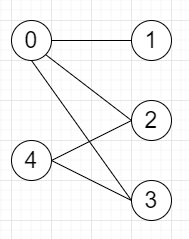
 Data Structure
Data Structure Networking
Networking RDBMS
RDBMS Operating System
Operating System Java
Java MS Excel
MS Excel iOS
iOS HTML
HTML CSS
CSS Android
Android Python
Python C Programming
C Programming C++
C++ C#
C# MongoDB
MongoDB MySQL
MySQL Javascript
Javascript PHP
PHP
- Selected Reading
- UPSC IAS Exams Notes
- Developer's Best Practices
- Questions and Answers
- Effective Resume Writing
- HR Interview Questions
- Computer Glossary
- Who is Who
Program to check whether given graph is bipartite or not in Python
Suppose we have one undirected graph, we have to check whether the graph is bipartite or not. As we know a graph is bipartite when we can split the nodes of the graph into two sets A and B such that every edge {u,v} in the graph has one node u in A and another node v in B.
So, if the input is like

Then the output will be True, [0,4] are in set A and [1,2,3] are in set B, and all edges are from A to B or B to A, not A to A or B to B.
To solve this, we will follow these steps−
Define a function dfs() . This will take source
-
for each vertex in graph[source], do
-
if color[vertex] is not same as -1, then
-
if color[vertex] is same as color[source], then
result[0] := False
return
go for the next iteration
-
color[vertex] := 1 - color[source]
dfs(vertex)
-
From the main method, do the following−
n := size of arr
graph := empty adjacency list for vertices 0 to n-1
-
for i in range 0 to n, do
-
for each j in arr[i], do
insert i into graph[j]
insert j into graph[i]
color := a list of size n and fill with -1
result := a list with one True value
-
-
for i in range 0 to n, do
if color[i] is same as -1, then
dfs(i)
return result[0]
Let us see the following implementation to get better understanding −
Example
from collections import defaultdict class Solution: def solve(self, arr): n = len(arr) graph = [set() for i in range(n)] for i in range(n): for j in arr[i]: graph[j].add(i) graph[i].add(j) color = [-1] * n result = [True] def dfs(source): for child in graph[source]: if color[child] != -1: if color[child] == color[source]: result[0] = False return continue color[child] = 1 - color[source] dfs(child) for i in range(n): if color[i] == -1: dfs(i) return result[0] ob = Solution() graph = [[1,2,3],[0],[0,4],[0,4],[2,3]] print(ob.solve(graph))
Input
graph = [[1,2,3],[0],[0,4],[0,4],[2,3]]
Output
True

